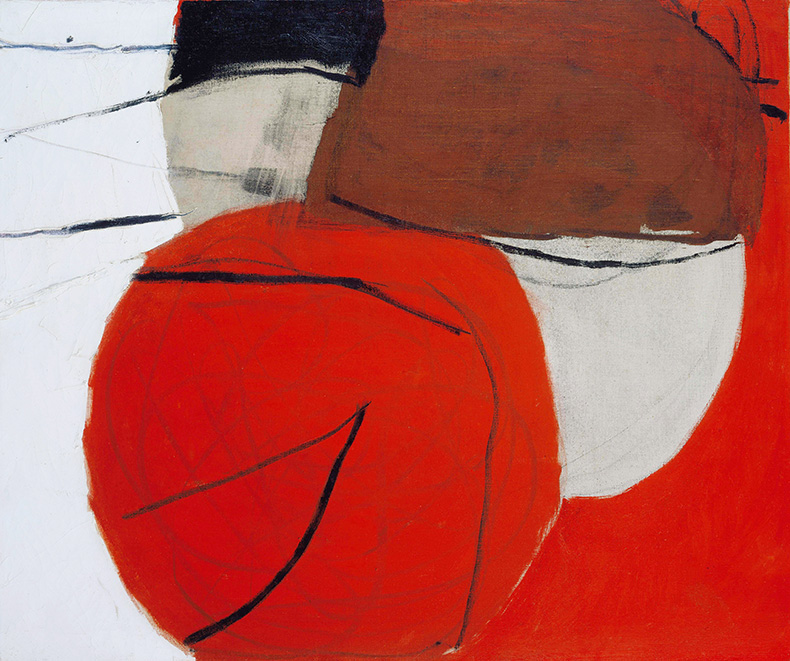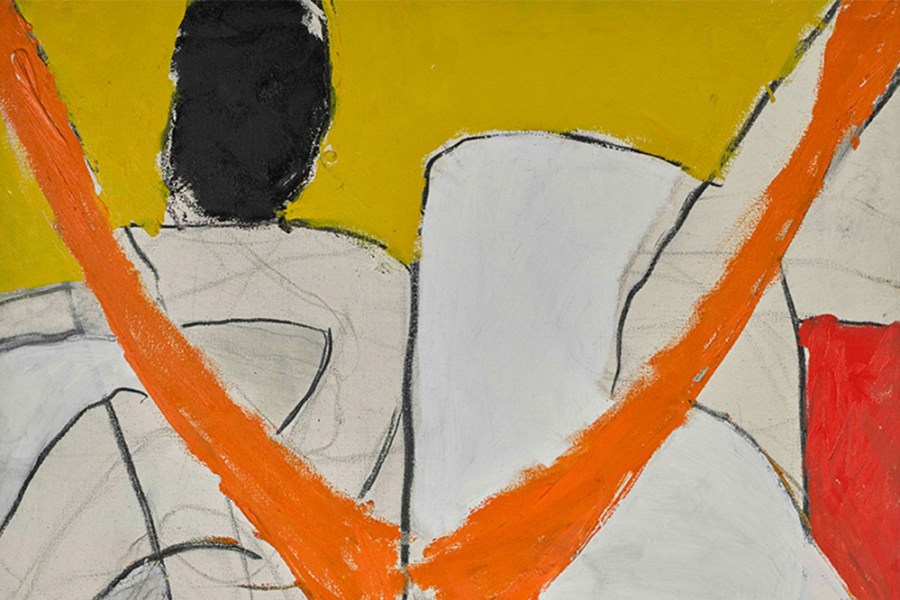Among the large canvases and boards dotted across the rooms at Jonathan Clark Fine Art is a charcoal drawing on paper. Roger Hilton’s floating face and neck would be little more than a smudge – if not for a pitch-black circular mouth and sunken fawn-coloured eyes, their pupils looking more like veins. The flesh is then encircled in a spiralling mess of charcoal lines resembling barbed wire.
At the end of his life, Hilton (1911–75) was confined to bed by chronic alcoholism. Too weak to work on canvas, he made small paintings using his children’s poster paints in a state of constant stupor. It’s an artistic setting immortalised in a poem by his friend W.S. Graham, ‘Lines on Roger Hilton’s Watch’:
The images of his dream
Are still about his face
As he spits and tries not
To remember where he was.

Self-Portrait (c. 1960), Roger Hilton. © Estate of Roger HIlton
Hilton’s Self Portrait (c. 1960) was drawn over a decade before his physical decline took over, but it feels like a premonition. In the catalogue of the JCFA show, Chris Stephens argues that Hilton’s poster paint works ‘can now be seen as one of the great bodies of an artist’s late work not unlike in some ways the late paintings of Picasso’. These are, indeed, the subject of a second Hilton exhibition in Winchester next month.
‘Violent Figuration’ focuses instead on a small selection of Hilton’s oil paintings of the 1950s and 60s, when – after decades based in London – he began to spend time in Cornwall, growing closer to the middle generation of St Ives painters. It was then too that his work became a major influence on David Hockney, among others. The exhibition takes its title from a letter Hilton wrote to fellow St Ives painter Terry Frost in 1955, in which he pondered ‘whether my next show will be of chaste abstracts or violent figuration’, before contemplating how the present moment had ‘untold possibilities of destruction, untold possibilities of building a new world’.

June ’60 (Red) (1960), Roger Hilton. © Estate of Roger Hilton
Stephens defines Hilton’s ‘unique style’ as maintaining a ‘formal harmony’ across the canvas while using contrasting textures and ‘asymmetrical arrangement of forms and colours’. We see this most strikingly in June ’60 (Red) (1960), in which the red centrepiece is scratchily brushed on to the canvas – but drawn to the eye by the thick layering of its white background. It’s a reflection of Hilton’s insistence: ‘Colours must be pinned down and kept in their place by other colours. A good picture takes place at the surface of the canvas, a bad one slightly behind it or in front of it.’ Here we see charcoal lines both behind and in front of the oil paint, lending the circular red shape a three-dimensional nature – yet the contrasting shades of these lines restore a flatness to the red, and place the action firmly on the surface.
Elsewhere, Hilton deploys similar build-ups of background colour to draw the texture of the canvas on to human flesh. In Two Figures (1971) the bodies are unusually whole for Hilton’s work, entangled below the waist and devastatingly separate above, implying a mental disconnection in spite of physical intimacy. It calls to mind another poem of Graham’s, ‘Hilton Abstract’, the first stanza of which concludes: ‘It is the longed-for, loved event / To be by another aloneness loved.’

Nude (c. 1962), Roger Hilton. © Estate of Roger Hilton
Nude (c. 1962) shows the human figure as if in the process of dismemberment, and full of Hilton’s characteristic eroticism, crude and captivating as ever. As Timothy Bond, one of the artist’s most dedicated scholars, puts it, ‘Hilton regularly played fast and loose with human anatomy.’ While he was not averse to depicting male sexual organs too, Hilton’s depiction of women’s bodies reveals the contradictions of his own masculinity – unsurprising, perhaps, for a man known for his violent tempers, banning his wife Rose from painting (she went on to a successful career after his death), and then latterly for his physical frailty. Both Nude’s orange ribbons, slanting from the top corners of the painting to enclose a triangular space , and the red apple-like shape below are suggestive of the vulva. But while the former cuts through the body parts in a display of sexual centrality, the latter is subservient, even repressed, by the body sitting above.
Stephens places Hilton ‘somewhere between the pure modernism of Europe in the early 20th century and the postmodern figuration of Hockney and the neo-expressionist work from the 1980s of artists like Jean-Michel Basquiat’. His paintings have somewhat less elevated surroundings in JCFA’s exhibition. Jonathan Clark gave up his Chelsea gallery space in 2019, so ‘Violent Figuration’ is hosted in his Clapham townhouse – with residential furnishings, office space and the materials of functioning art dealership all providing a backdrop. On the bookshelves in the sitting room, I find a copy of David Jones’s epic poem In Parenthesis, published in 1937, a reflection of the First World War as Europe hurtled towards the Second.

Two Figures (1971), Roger Hilton. © Estate of Roger Hilton
On display, Hilton’s January ’69 (1969) looks like a scene of fertilisation, its flower the product of penetration – and it came a few years after the birth of the artist’s two sons with Rose. But in the catalogue it is rotated 90 degrees anticlockwise, rendering the central image more eye than egg, and calling to mind another epic poem of the 1930s, George Barker’s Calamiterror, in which we witness the ‘eye dividing’ in ‘the limbo-circus of the human ’ amid the horror of the Spanish Civil War.
‘The tyranny of the image must be overcome,’ Hilton wrote on a loose sheet in the 1950s, saying of abstract paintings: ‘If they move you, do not believe it is an image which moves you, but rather that they are linking you in some mysterious way with the obscure forces which govern our lives.’ But in Hilton’s paintings and in the art of Jones and Ceri Richards, destruction was never far from rebirth. In seeking to overcome the image, Hilton could not help but reinvent figuration.
‘Violent Figuration’ is at Jonathan Clark Fine Art, London, by appointment until late December.
Unlimited access from just $16 every 3 months
Subscribe to get unlimited and exclusive access to the top art stories, interviews and exhibition reviews.














![Masterpiece [Re]discovery 2022. Photo: Ben Fisher Photography, courtesy of Masterpiece London](http://www.apollo-magazine.com/wp-content/uploads/2022/07/MPL2022_4263.jpg)
It’s time for the government of London to return to its rightful home